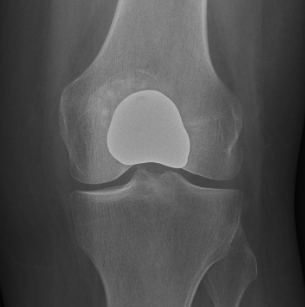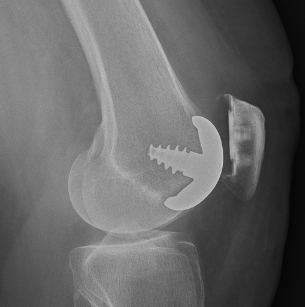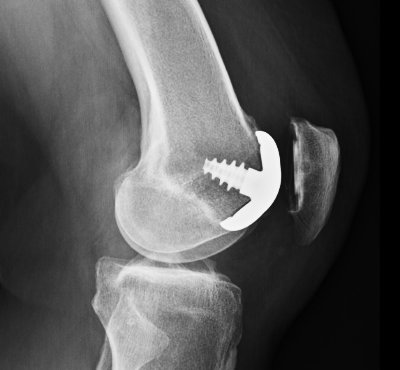A partial knee replacement (or unicompartmental knee replacement) replaces one region (compartment) of the knee with a metal and plastic implant.

Tibiofemoral partial knee replacement, replacing one compartment of the joint.

Hemicap patellofemoral replacement from the front.

Hemicap patellofemoral replacement from the side
Knee replacement and the concept of 'compartments'
Where the bones articulate in the knee is called a 'compartment' - the two articulations of tibia and femur are called the medial and lateral compartments, while the articulation of patella and femur are called the patellofemoral compartment. Replacing the joint of any of these compartments is called a 'partial' or 'uni-compartmental' knee replacement.
What is a partial knee replacement?
A partial knee replacement is the replacement of only one articulation of the knee joint with components manufactured from metal and plastic. It may also be called a unicompartmental knee replacement. This may be one or other of the two tibiofemoral joints (joint involving tibia and femur bones) or the single patellofemoral joint (between kneecap and femur bone).
Tibiofemoral replacement

This is an X-ray showing a tibiofemoral partial knee replacement. The metal shows up as white, and the gap between the two metalllic bits is the plastic spacer (which does not show up on X-ray).
Patellofemoral replacement
This procedure may also be called 'resurfacing' . A metal component replaces the damaged trochlear groove of the femur, and a plastic button replaces the rear patellar surface which is cut away to accommodate the implant.

The trochlear implant is comprised of metal and shows up as white. The plastic patellar component is showing only as a space between the trochlear implant and the remainder of the patella.
What are the indications for partial knee replacement?
Surgeons usually choose a partial over a total knee replacement when the damage to the joint cartilage is limited to one compartment (articulation), and when the rest of the joint is still in relatively good condition. Also the alignment of the limb should be good with frontal deformity of less than 15° and flexion contracture of less than 15°. The ligaments are the knee need to be uncompromised, especially the anterior cruciate ligament, and there should be no acute inflammatory process going on inside the knee. Finally, patients in general should be chosen from the middle-aged group, who would normally be considered too young for a knee replacement.
Complications of unicompartmental arthroplasty
Complications may include:
- implant subluxation
- polyethylene wear
Update on unicompartmental knee arthroplasty Vasso M, Antoniadis A and Helmy N. EFORT open reviews vol. 3,8 442-448.